BY ROB FELD
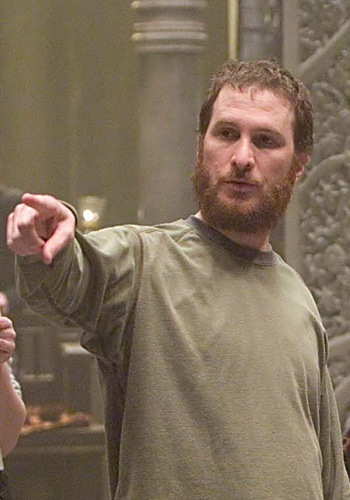 PERFECTION: Darren Aronofsky says
PERFECTION: Darren Aronofsky says
every shot of Yojimbo makes sense.
“It’s given me the faith to go back
to work.”(Credit: Takashi Seida)
"This film nears perfect construction in that the theme and the characters are so clear," says Darren Aronofsky, director of
Pi and
Requiem for a Dream, as the music and titles for Akira Kurosawa's
Yojimbo come up. "Every shot in every scene makes sense. That, to me, has always been the goal—to make a film where every shot is relating back to what the movie is about, pushing a narrative down to its key elements and stringing them together to tell a story."
Yojimbo, based loosely on the Dashiell Hammett novel
Red Harvest, was itself the basis for
A Fistful of Dollars and
Last Man Standing. It follows a wandering samurai, Sanjuro, played with remarkable grace by Toshirô Mifune, as he enters a town torn between two warring factions of gamblers. Sanjuro, ultimately showing greater interest in righteousness than financial profit, proceeds to play each side off of the other until both are destroyed.
"Here, when we meet the character, it starts with a wide shot on nature and the unconquerable mountain range, then it pulls focus before he enters and steps into the frame," notes Aronofsky, sitting on a couch in his New York office. "You don't see Mifune's face for the whole title sequence, but you get so much of his character from the way his hair is strained, the way he carries himself, scratches himself, reaches his hand into his robe. He immediately creates a character. I love the way Mifune and Kurosawa always give the character a little twitch—rolling his shoulders around, stroking his beard."
Sanjuro follows a path and encounters a farmer trying to keep his rebellious son from leaving for town to make his fortune with the warring gamblers. "The framing is just perfect," Aronofsky says, as Sanjuro stops, slightly out of focus in the background, positioned between the arguing father and son on either side before him. "The story is about two sides of the town fighting, and how Sanjuro becomes a player and uses the power of each to destroy the other. But even in that opening shot, he's smack in the middle of a father-and-son battle."
"Who wants a long life eating porridge?" the petulant son cries as he runs off to town. "At the end of the film Kurosawa pays this off and he is the one kid who survives," Aronofsky says.
In the next scene, Sanjuro takes some water while the farmer argues with his wife. Again, the samurai is positioned in the background between them, though the three figures largely occupy only the right half of the screen. "From the way in which they are all blocked, you understand exactly what's going on with everyone. You don't even need dialogue. If you can block well enough, it explains what the characters are doing and feeling. That's ultimately the intention, always."
As Sanjuro enters the town, people hiding behind shuttered windows peer out so they can see what's going on. The first living creature he encounters, however, is a dog trotting along with a severed human hand in its mouth. "A town under siege," Aronofsky comments, which seems like an accurate reading of the scenario. "The music is playful and humorous but still has drive and suspense. The instrument playing the low notes maintains the drive."
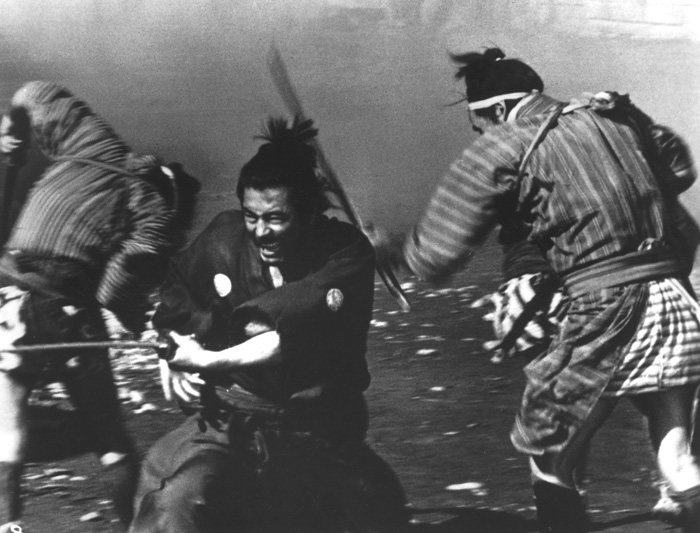 THE GOOD GUY: Toshiro Mifune plays a righteous samurai
THE GOOD GUY: Toshiro Mifune plays a righteous samurai
who gets caught in the middle of two warring gangs
in Kurosawa's Yojimbo (1961). (Credit: Photofest) Sanjuro befriends the tavern keeper, Gonji, and situates himself in his establishment, learning the lay of the land and plotting his next move. "Everything is set up so perfectly," Aronofsky says. "Like the way the line about how the coffin maker, 'can't make coffins fast enough,' pays off later. There's no waste in this film and that, to me, is what's so inspirational; it's boiled down to the bare necessities of what it is to make a film."
As Sanjuro and Gonji watch, the drama's distinctive characters are introduced, and through skilled casting and quick brush strokes, they are rendered instantly identifiable to the audience. Kurosawa efficiently sets the pieces on the chessboard so that they can be quickly called upon later to fill their roles in the narrative. "I think it's important to establish a character as quickly as you can," Aronofsky says. "I always try to introduce my stars with a close-up. The beauty of film is that you can put the camera five inches away from Paul Newman's face and stare into those blue eyes, without being at all self-conscious. There's nothing like being able to look at a person in a dark room and experiencing their emotions without being self-conscious of them looking back—especially when they're having some of the deepest emotions that people feel."
"Kurosawa is setting up the information, locations and visual rules of the film," Aronofsky says. "His attention to geography is brilliant. He's a war general, in that sense. In Seven Samurai, when the samurais draw in the sand and lay out the plan, he tells you the entire movie, right there. You get so many films today with shootouts, where you don't know what the hell's going on. But when Kurosawa picks his shots for the battle scenes, everything makes perfect sense."
Aronofsky marvels at how Kurosawa pays off his setups, and leans forward in anticipation of Mifune's punch line, after he easily slaughters the first group of gangsters. "Cooper, two coffins. No, maybe three," he says to the coffin maker. Mifune drops the line and tosses away his toothpick in a true movie star moment, as the now familiar music kicks back in. "That is, I think, the first hero one-liner," says Aronofsky. "It's the beginning of 'Hasta la vista, baby,' or 'I'll be back.' All those heroes were built out of this guy—that mix of comedy and action is something that people are still doing today. It's a great film moment. Everything comes together: blocking, lighting, special effects, sound, the theme of the film. I used to have it on VHS and I watched that sequence so many times I actually ruined the tape from cueing it up in the same place over and over again."
Making a deal with one of the gang bosses, Sanjuro looks out at the field before him and comes up with a name for himself, Kuwabatake [Mulberry Field] Sanjuro, to which Aronofsky responds, "that's the whole spirit of samurai films; this wandering soul who is so of the time, place, moment and environment, and connected to nature."
As Sanjuro sits in a meeting with a gang boss and his scheming wife, the boss' fighting instructor is angered by Sanjuro's presence. In his staging, Kurosawa's mastery of composition becomes immediately apparent: he creates four levels to the depth of field and four eye lines. "Look at that framing," Aronofsky says of what, in lesser hands, could have been a painfully dull shot. "There is so much sitting in Japanese period pieces and you can create so much geometry in the blocking. It's harder to do stuff like this in American films, but the way he balances out the frame has definitely inspired a lot of my work. The balance is created by opposites perfectly pulling on each other, almost like isometric workouts. The closest I've come is in my new film The Fountain, which grew from the necessity of trying to create screen direction for a character who is supposed to be in zero gravity."
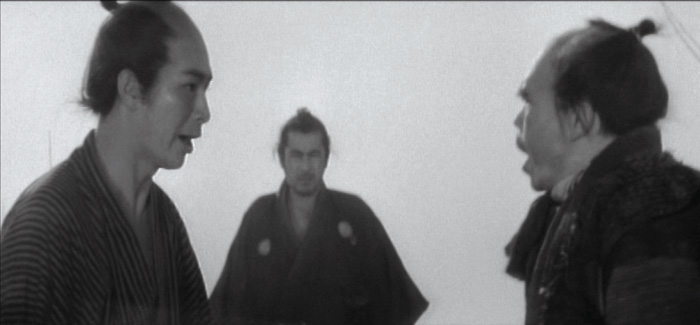 MIDDLEMEN: At the start of Yojimbo, Kurosawa frames an argument between
MIDDLEMEN: At the start of Yojimbo, Kurosawa frames an argument between
father and son with Mifune placed strategically between them. (Credit: Criterion)"Once again, environment is so crucial in Kurosawa's work," Aronofsky says a moment later, as he watches the wind picking up outside, sending leaves tumbling along the ground. "The guy uses wind like nobody else. Most people wouldn't take the time and effort to put that detail in, to put the giant fans up and dress the leaves. It adds so much character to the town, but I think the wind has a lot to do with Sanjuro's character, as well; blowing into town, blowing out of town, ripping apart whatever it bumps into."
"I think every film has its own grammar," Aronofsky continues, "and the job of the filmmaker is to find the visual language that tells his story best. You can't force your style or stuff you've done before onto a new film. When I started The Fountain, I realized that the subject matter was very different than anything I'd done before in Pi or Requiem. I needed a new visual style to tell the story and we got rid of a lot of things that people have come to expect of my films."
Now, half way through Yojimbo, Kurosawa throws in a twist—a member of one of the gangs, Unosuke, returns to town with a revolver and has his first wordless face-off with Sanjuro. "We know that the big standoff is yet to come," Aronofsky says. "All the bad guy moments in the Bond films, so much is taken from this. It's the same as the bad guy with the silver teeth. The gun adds complication because you don't know how Sanjuro, with his sword, will ever defeat the gun but you know he'll eventually have to face it. It's the kryptonite of the movie."
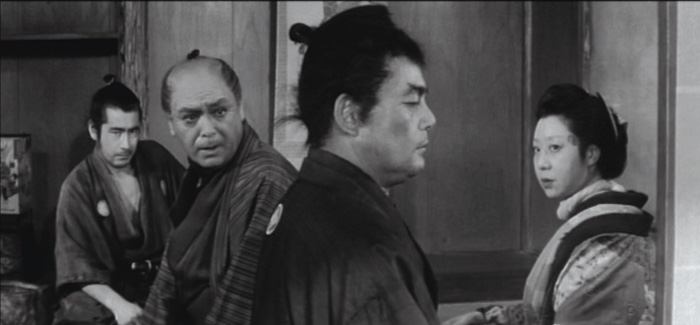 Kurosawa's masterful composition creates four sight lines in a meeting
Kurosawa's masterful composition creates four sight lines in a meeting
with a warlord and his scheming wife.The big surprise in the story comes when Sanjuro overplays his hand and is caught by one of the gangs, beaten and locked in a room. "Even here, when he lands right in the patch of light, it's brilliant work with cinematography," Aronofsky says. "Just his right eye in the light, then bam! A jump cut." Sanjuro's eye in the light, the one not too swollen to see, widens and Kurosawa cuts to an open padlock, then wider on the trunk on which the lock hangs, where Sanjuro realizes he can hide. "He only uses jump cuts twice in the film—right here and out in the field, when Sanjuro chooses his name. When you use a visual thing like a jump cut, it's great to use it more than once so it becomes part of the language."
Sanjuro escapes his captors in a ploy that Aronofsky says feels very modern—he hides in the box, then flees when his captors leave the door open as they go searching for him. Sanjuro's time for laying back is clearly over and the stage is set for his confrontation with Unosuke and his revolver. As Gonji assists him in his escape, he slips Sanjuro a dagger, something that will later become his secret weapon. "Even that dagger he just gave him is set up here so nonchalantly, when you're wondering how he's going to defeat the guy with the gun. It's done so brilliantly," Aronofsky says.
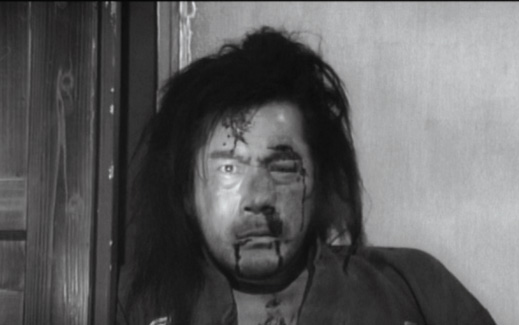 Mifune's one good eye is visible in a patch of light after he is
Mifune's one good eye is visible in a patch of light after he is
beaten and locked up.The standoff comes as Sanjuro and Unosuke face each other in the street, as they would in any Western. They approach slowly, Unosuke's cronies behind him. "How's he going to defeat the gun?" Aronofsky cries. The dagger can be seen protruding from Sanjuro's tunic. "There it is—the weapon, waiting. When he acts it's so quick. So sudden, no run-up to it. It just takes off by itself." Sanjuro fakes left, then right, then flings the dagger at Unosuke, catching him in his shooting arm. The kryptonite neutralized, Sanjuro proceeds to clean house like a hero should, but sparing the farmer's son from the beginning of the film. "Go home. A long life eating porridge is best!" Sanjuro tells him. "And thus he fully redeems the circle of the film, just where it started off. It's great," Aronofsky says with satisfaction.
While Yojimbo is stylistically worlds apart from Aronofsky's hyperactive first two films—Pi and Requiem for a Dream— and the upcoming dreamlike landscape of The Fountain, his narratives often conclude with direct references to the beginning of the film, while images and themes repeat themselves throughout, much as they do in Kurosawa's movies.
"It's amazing how some films can just stretch across culture and time and still make so much sense," he says, leaning back as the screen fades to black. "That's the goal—to make something that works so well that people will continue to enjoy it for years to come. Again, it's given me faith to go back to work. Sometimes it's hard to know where to stick the camera, but I think when you watch a film like this, you get inspired that there is always that one place where the camera is supposed to go. I use that as something of a mantra when I'm starting to visualize a film—there really is only one place where the camera goes; it needs to come out of what the scene is about, but ultimately what the theme of the film is. If you know what that is, then you really, in your gut, can only place the camera in one place. Yojimbo is an exercise in that, and proof that it's achievable."